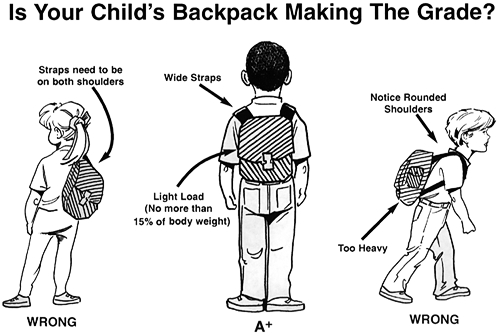Backpack Safety
By Rob Abrams MSPT, posted on November 18, 2013Recently, there has been a growing concern over the use of backpacks and the safety concerns they present for today’s youths. This issue is receiving increased attention among many in the medical community and even in the California Legislator. It has been stated that nonspecific back pain increases from less than 10% in the pre teen years on upward to 50% among 15 and 16 year olds. Much of the research attributes this prevalence to backpacks.
Too many kids are carrying excessive backpack loads which are adversely affecting posture and spinal alignment.
Arching, bending and leaning to the side causes improper functioning of the vertebral disks; increases the likelihood of strains and sprains of the neck, shoulders and back; and causes muscles to work harder leading to fatigue and strains.
The American Academy of Pediatrics and The American Physical Therapy Association recommends backpack loads not to exceed 10 to 20% of a child’s body weight. Loads greater than 10% have been shown to produce postural changes and require more energy. Dr. Shelley Goodgold an associate professor of physical therapy at Simmons College surveyed 5th through 8th graders and found that 55% carry loads greater than 15% of their body weight.Many communities are becoming more proactive with respect to backpack safety. Some counties are issuing extra copies of text for home, texts on CD and adopting back pack safety programs which teach proper usage and knowledge. While no formal guidelines exist the APTA and other health care professionals recommends the following guidelines when wearing and choosing an ergonomic backpack.
Backpack Safety Guidelines
- Padded Back: A pack should be padded to protect the back and worn over the mid back so the strongest muscles carry the load. It should not hang below hip level.
- Hip and chest belts: These helps to re-distribute weight to the pelvis.
- Multiple compartments: This allows for evenly distributing objects and loads into different areas of the pack.
- Compression straps: These help to stabilize articles and draw the heavier objects closer to the back.
- Proper Loading: Pack heavier items first so that they are lower and closer to the body.
- Padded Straps: This helps decrease pressure points on the shoulders and chest.
- Reflective Material: This allows the wearer to be seen more easily.
- Wearing both straps: This allows for even distribution of the load. A single strap will alter posture. Messenger style packs are not recommended.
- No loads greater than 10% to 20%: Keeping the backpack weight to no greater than 10% of the child’s body weight dramatically decreases the risk of potential injury.
The American Physical Therapy Association highly recommends The Land’s End Collegiate and Collegiate Junior backpacks based on safety and comfort. You can read more about these products at www.landsend.com
While backpack weight is probably the single most important safety factor to take into consideration, knowing how to wear you backpack is also very important. See the figure below to see if your backpack is “making the grade”. Courtesy of the APTA

Finally, be able to recognize the warning signs that your backpack is too heavy. Be alert to:
- Changes in posture
- Struggling when putting the pack on
- Pain while wearing the backpack
- Tingling or numbness
- Red marks
If these or any other symptoms arise while wearing your backpack, consult your family doctor or physical therapist.
